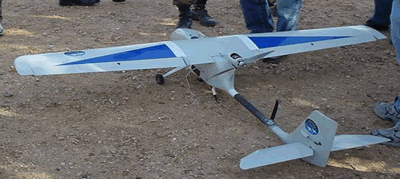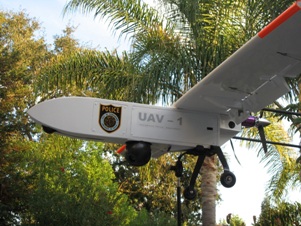UAV successfully flies over Amsterdam
5 July 2004 - In an historic flight, being touted as the first UAV to fly in the crowded airspace of a major western European city, the 1.5 m long Birdeye 500, with a 2 m wingspan, demonstrated its low level surveillance capability over Amsterdam, Netherlands.

Birdeye 500 UAV from http://www.defense-update.com/products/s/spythere.htm
The 5 kilogram electric Birdeye, developed by Israel Aircraft Industries-Malat, uses a MicroPilot MP2028g autopilot for navigation. The Birdeye, with an endurance of one hour, is equipped with a zoom-capable, 850 gram, daylight colour video camera that is interchangeable with an infrared sensor, for night surveillance.
The demonstration was organized by the Dutch distributor (Condor UAV) for the Amsterdam metropolitan police. The flight was performed at an altitude at 500 feet and a speed of 40 knots. The aircraft inspected railways tracks, passenger terminals for the ocean liners and had to manoeuvre between lamp posts, before landing safely. Howard Loewen, President of MicroPilot, stated "This test flight makes a point to the world that mini-UAVs are safe, from police to farmers and countless other applications."
Sacramento Police Unmanned Aerial Vehicle Program Gaining Altitude
from http://www.govtech.com/e-government/102472759.html

Photo: Courtesy of Sacramento Police Dept.
Sep 27, 2007. By Jim McKay.
The Sacramento, Calif., Police Department announced its Urban Unmanned Aerial (UAV) Vehicle Program and showed off its unique homegrown version of the Unmanned Aerial Vehicle at the Versadex Conference in downtown Sacramento.
The mini airplane on display was one of two aircraft in the development stage designed to enhance the department's existing airborne technology program. The current program consists of two helicopters with video downlink communications that stream video to mobile data terminals in police patrol cars and to mobile command vehicles.
The UAV will give the department an affordable - not to mention quieter -- alternative to the hovering helicopter during incidents, said Police Chief Albert Najera, who said the department gets many complaints about the noise of the helicopters. " The noise factor is huge. This is almost silent, you can't hear it," he said. " Not many police departments can afford a helicopter, but most will be able to afford this."
Najera said the UAVs will give the department an option during floods when the helicopters are used to shine infrared light on the levees to detect leaks. The UAVs will be able to do the same thing, freeing up the helicopters to handle critical calls.
"I wish I had a dollar for every time I've heard over the radio 'Is an air unit available?'" said the developer of the aircraft, Mark Bateson, senior solution architect of public safety IT for the department.
The 5-foot-long aircraft weighs about 12 pounds and can carry multiple video cameras. It is hand-launched and can circle autonomously for 45 minutes at about 30 mph.
It has " stare capability," which means it can train the video on a subject for its entire flight. " With a right click, I can give it latitude and a longitude and point the camera," Bateson said.
The aircraft is battery operated, flies autonomously for the most part and even calculates the direction and speed of the wind while in flight. Bateson said the next step is to pursue Federal Aviation Administration (FAA) certification and authorization. "It is our intention to work in a cooperative teaming arrangement with the FAA to make this work and follow the book, so to speak, to make this a success."